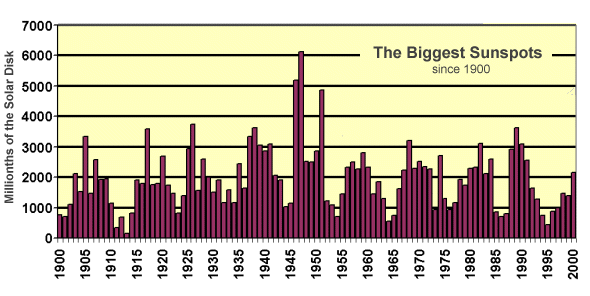|
back to spaceweather.com Astronomers measure the sizes of sunspots as fractions of the Sun's visible area. Their favorite units are "millionth's." A sunspot that registers 1 millionth has a surface area equal to 0.000001 times the area of the Sun's Earth-facing hemisphere. Typically, a big sunspot measures 300 to 500 millionths. The entire surface area of the Earth is only 169 millionths of the solar disk.
AR9393 was a whopper, but there have been plenty of larger sunspots. The plot below -- based on data provided by Dr. David Hathaway, a solar physicist at the NASA/Marshall Space Flight Center -- shows the size of the biggest individual spots in each year between 1900 and 2000. Notable spots include the Great Sunspot of 1947, which was three times larger than AR9393, and a large sunspot in March 1989 that triggered an historic geomagnetic storm.
|
 On
March 29, 2001, active region 9393 became the biggest sunspot
since 1991. The behemoth spot registered 2400 millionths, or
14 times larger than Earth. Watch
AR9393 evolve in
On
March 29, 2001, active region 9393 became the biggest sunspot
since 1991. The behemoth spot registered 2400 millionths, or
14 times larger than Earth. Watch
AR9393 evolve in 